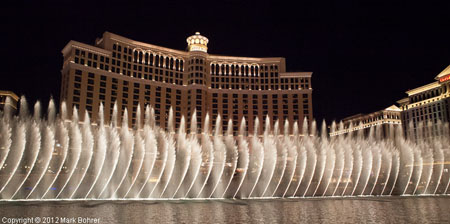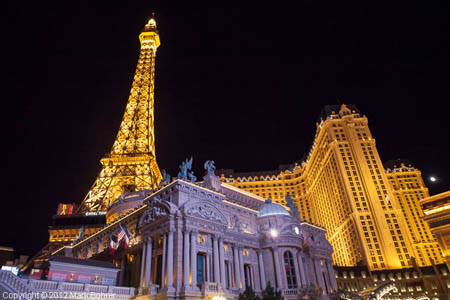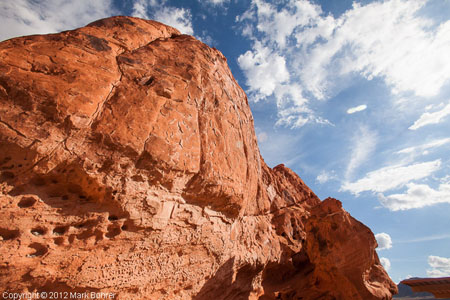Say ‘Las Vegas’ to most people, and they picture the glitter of the Strip, jingling jackpots, and croupiers hauling chips off the board at the roulette tables.
But Las Vegas sits in the middle of red, orange and white stone sculpture gardens rivaling anything the world has to offer. The highest cost of these attractions is for the gas to reach them. Entrance fees are below ten bucks.
Just west of town, Red Rock Canyon National Conservation Area has blocky layers of colored sandstone much prized by rock climbers. You’ll get dramatic colors from those layers in sunset light for landscape photography too.
It’s administered by the BLM, so your leashed dog is welcome on trails.
We arrived 90 minutes before sunset, and photographed from trailheads and overlooks. I wished there’d been time to walk trails into the aptly-named Calico Hills for more intimate shots of the rock and climbers. There was at least one climbing party enjoying top-roped ascents and rappelling descents of one pitch, until it got too dark for climbing and photography.

I hadn’t been to Vegas for years, so my wife insisted I see the fountains at the Bellagio. I had a front row view, and braced my elbows on a stone post to get sharp shots at high ISO. While I was waiting for my wife to circle around with the car, I had time to photograph the faux Tour Eiffel and skyline.

The other jewel sits an hour northeast of town. Valley of Fire State Park opened in 1934, Nevada’s first state park. Its name is an accurate description – the place looks ablaze, especially in sunrise or sunset light. Strange rock sculptures and rock art alone make this place worth visiting.

I was suffering the effects of mild food poisoning the day we toured Valley of Fire. (Avoid the complimentary breakfast at Howard Johnson’s in St. George, Utah.) Distant thunderstorms and rain gave dramatically dark skies and saturated color – it all led to great photographs. I managed to spot some very subtle pictographs on the back of a fallen slab in the Seven Sisters area. But there’s much more rock art in this park, and I want to see it when I feel better. We’ll be back…
If you see what looks like several gantries for a desert rocket launch site crossing the Nevada-California border on I15, stop and take a closer look. This is a set of solar-thermal power towers in the Ivanpah Valley. When it’s complete the facility will provide 392 MW of power to customers in southern California and Nevada.
Shot Notes
Wide angles may be used for wide coverage of large subjects, but this usually crams too much distracting detail in a frame.
You’re usually better off using wides to invite your viewer into the frame. Find a striking foreground rock or texture, focus on it, and arrange other distant rocks and mountains to lead your viewer’s eye around the picture. You can also find a close rock texture and play it off against clouds, like the opening shot above.
My first serious camera was a Leica M3, much used by newspaper shooters in the 1950s and 1960s. I became accustomed to shooting reportage-style with it over the years. That was how I shot this trip, handholding or bracing the camera against found objects. While I dislike its lack of camera stability, Live View helped me get some unusual views.
ISO 6400 is quite useable in low light with relatively recent dSLR cameras like the EOS 7D and EOS 5D mark II I was using.
I left my Leica M8 home this time. Its high-ISO performance is very disappointing, and its sensor requires manual cleaning. The Canons have built-in vibrational sensor cleaning, making them much simpler to use and maintain. But they are bigger and heavier. It’s a tradeoff you always face.


Recent Comments